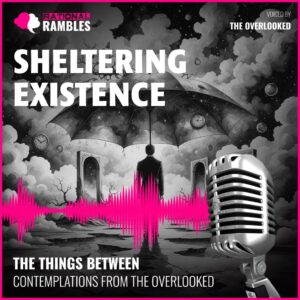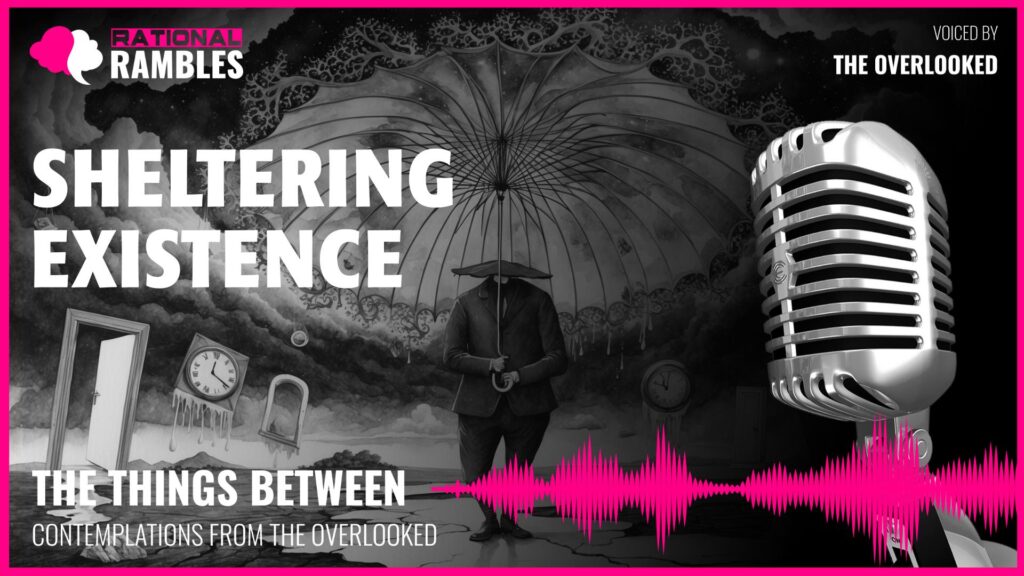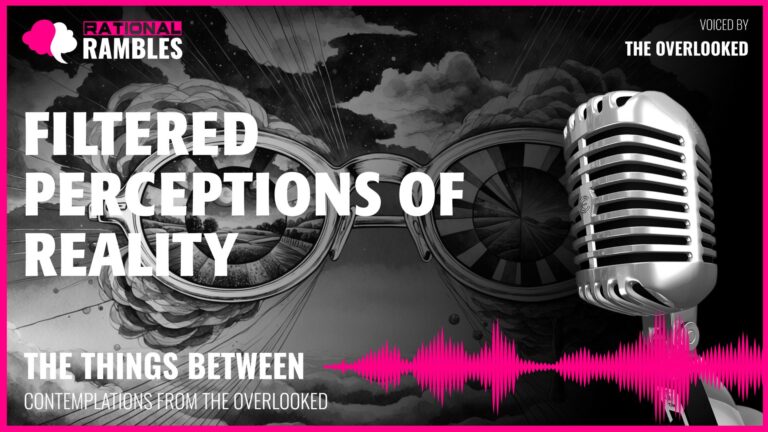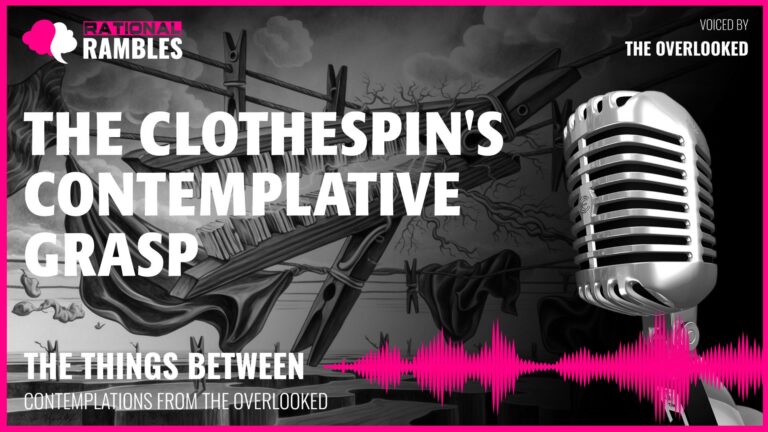The Architecture of Protection: Boundaries, Purpose, and the Spaces We Create
Introduction
In the interplay between vulnerability and shelter, we discover the fundamental architecture of human existence. Protection is not merely a physical act but a philosophical position—a deliberate creation of boundaries that define where threat ends and safety begins. This liminal space between exposure and security reveals profound truths about purpose, temporality, and the nature of care. When we examine the act of protection closely, we find it is not about eliminating threats but about creating defined spaces where those threats cannot penetrate. These temporary sanctuaries—physical and metaphorical—become the stages upon which human connection unfolds, where meaning is constructed, and where purpose finds its truest expression.
This exploration delves into the philosophy of protection and the significance of boundaries in human experience. We will consider how protective acts simultaneously define both what we value and how we relate to environmental forces beyond our control. Through examining the nature of protective boundaries, the meaning of purpose in transient circumstances, and the complex relationship between protector and protected, we uncover a rich philosophical landscape that illuminates not just how we shelter what we value, but how that very act of sheltering shapes our understanding of existence itself.
The Ontology of Boundaries
Protection, at its essence, is not about eliminating threats but about creating boundaries—physical or conceptual demarcations that separate safety from danger. These boundaries do not destroy the threat; they simply define spaces where the threat cannot reach. This distinction is philosophically significant. It suggests that much of human security is not about mastering or eliminating the hostile forces of our environment but about carving out territories where those forces are temporarily held at bay.
The Creation of Negative Space
There is a peculiar ontological status to protected spaces—they exist as negations, defined by what does not occur within them. Success in protection is measured by absence: the absence of harm, the absence of intrusion, the absence of threat. This presents an interesting philosophical paradox: how do we evaluate something that is defined by what doesn’t happen rather than what does?
The 20th-century philosopher Martin Heidegger might have recognized this as a manifestation of what he termed “the clearing” (die Lichtung)—a space opened up within being where truth can reveal itself. Just as a forest clearing is defined by the absence of trees, protective boundaries create clearings in the landscape of potential harm, spaces where different possibilities can emerge.
Social theorist Michel Foucault observed that power often operates through exclusion, by defining boundaries between the normal and the abnormal, the allowed and the forbidden. In the context of protection, we might say that the power of boundaries lies precisely in their ability to exclude threatening elements. The protected space becomes meaningful through what it keeps out.
Circular Horizons and Temporary Worlds
Many forms of protection create circular boundaries—mobile horizons that travel with the protected. Consider how a spotlight creates a circular zone of visibility in darkness, how a tent establishes a cylindrical domain of shelter in wilderness, or how a protest circle creates a protected space for vulnerable participants. These circular boundaries establish miniature horizons, portable worlds with their own internal logic and conditions.
Philosopher Gaston Bachelard wrote extensively about the phenomenology of intimate spaces in his work The Poetics of Space. He noted that “all really inhabited space bears the essence of the notion of home.” Protected spaces, regardless of their temporality or scale, share this quality—they become micro-homes, territories of safety that we inhabit temporarily but completely.
These portable horizons raise intriguing questions about the nature of world-creation. If, as Heidegger suggested, humans are fundamentally “world-building” beings, then the act of creating protective boundaries represents one of our most basic world-building functions. We do not merely exist within the world; we actively create worlds within the world—smaller domains where different rules apply and different possibilities emerge.
The Permeability of Boundaries
No protective boundary is absolute. Wind may penetrate a shelter, water may find its way through a roof, security systems may be breached. This inherent permeability reveals something significant about the nature of protection itself—it is always conditional, always vulnerable to sufficiently powerful intrusions.
Buddhist philosophy emphasizes impermanence (anicca) as a fundamental characteristic of existence. The inherent vulnerability of protective boundaries can be seen as a manifestation of this impermanence. No shelter lasts forever; no protection is absolute. Even the most seemingly permanent protective structures—castle walls, sea barriers, institutional safeguards—eventually yield to time, force, or erosion.
Rather than undermining the value of protection, this permeability highlights its precious, contingent nature. Protection becomes not a permanent solution but an ongoing practice, a continuous response to changing threats. The philosophical value of boundaries lies not in their perfection but in their persistence despite imperfection—in the human commitment to maintain them despite knowing their ultimate fragility.
The Temporality of Protection
Protection exists in a unique temporal dimension, characterized by cycles of dormancy and activation, readiness and deployment. This cyclical nature reveals important insights about how purpose and meaning function within temporary contexts and how the measurement of time itself changes when viewed through the lens of protective action.
Potential and Actuality: The Aristotelian Dimension
Aristotle distinguished between potentiality (dynamis) and actuality (energeia)—a distinction that illuminates the temporality of protection. Protective objects or systems spend most of their existence in a state of potentiality: folded, stored, waiting. Their actuality—their deployed, active state—may represent only a small fraction of their temporal existence.
This creates an interesting inversion of traditional value hierarchies. While Western philosophy has often privileged actuality over potentiality (with Aristotle himself suggesting that actuality is prior to potentiality in formula, time, and substantiality), protective objects derive their primary value from their potential. Their worth lies not in constant use but in reliable readiness. A fire extinguisher that is never used may fulfill its purpose perfectly; an emergency protocol that is rarely activated may be the most successful.
Contemporary philosopher Giorgio Agamben has revisited the concept of potentiality, suggesting that it is not merely the absence of actuality but a positive mode of existence in its own right. He writes that potentiality “maintains itself in relation to its own privation, to its own non-Being.” This perspective helps us understand how protective entities maintain their essential purpose and identity even when dormant. They exist in a state of positive potentiality—ready, capable, and defined by this readiness rather than diminished by their periods of inaction.
Measuring Time Through Purpose
The cyclical nature of protection suggests an alternative temporality—one measured not in linear chronological units but in deployments, in purposes fulfilled, in moments of need met. This functional time differs fundamentally from clock time. It accelerates during crisis and expands during preparedness; it compresses days of inactivity and elongates moments of utilization.
Henri Bergson’s concept of “duration” (durée) provides a philosophical framework for understanding this non-linear temporality. Bergson argued that real time—as experienced subjectively rather than measured mechanically—is not homogeneous but varies in intensity and significance. The time of protection follows this pattern, expanding and contracting according to need rather than flowing at a constant rate.
This alternative temporality extends to the aging process as well. Protective objects age not primarily through chronological time but through use—through deployments, through purposes fulfilled. Their wear becomes a record of protection provided, a physical manifestation of function expressed. The worn handle, the frayed edge, the patina of use—these are not simply signs of deterioration but testimonies to purpose fulfilled, markers on a timeline measured by utility rather than days.
The Kairos of Protection
Ancient Greek distinguished between chronos (sequential time) and kairos (the right or opportune moment). Protection operates primarily in the realm of kairos—it concerns itself not with the steady passage of time but with the critical moment of need. The philosophy of kairos suggests that certain moments possess special significance, carrying opportunities that other moments do not.
Protection exists for these kairotic moments—the crisis, the emergency, the sudden shift from safety to danger. Its value lies in recognizing and responding to these critical junctures. In this sense, protection represents a kind of temporal wisdom—an acknowledgment that time is not homogeneous but contains moments of particular vulnerability that require particular responses.
This kairotic dimension of protection explains why preparedness itself holds value. To be prepared is to acknowledge the unpredictable nature of kairos—to recognize that the critical moment may arrive without warning and that readiness must precede need. The person who carries protection before the threat materializes demonstrates a philosophical understanding of time’s uneven terrain, its hidden precipices and sudden storms.
The Paradoxes of Purpose
The philosophy of protection reveals several apparent contradictions that, upon closer examination, offer profound insights into the nature of purpose itself. These paradoxes help us understand not just the specific function of protective boundaries but the broader question of how purpose operates in human life and material objects.
Success Through Absence
Perhaps the most striking paradox of protection is that its success is measured by what doesn’t happen rather than what does. The perfect fulfillment of protective purpose creates no positive outcome but simply prevents a negative one. This inverts conventional metrics of achievement, which typically measure positive creation rather than negative prevention.
This paradox connects to broader philosophical questions about the nature of goodness. Is good merely the absence of bad? Is health simply the absence of illness? Is peace merely the absence of conflict? Protection forces us to confront the philosophical status of absence and negation in our evaluation of success.
The Daoist concept of wu-wei (non-action or effortless action) offers one framework for understanding this paradox. In Daoist thought, the highest accomplishments often come not through forceful intervention but through creating conditions where problems do not arise. The Dao De Jing suggests: “The sage does not attempt anything very big, and thus achieves greatness.” Protection embodies this principle—its greatness lies precisely in preventing the need for greater intervention.
The Dignity of Waiting
Protection spends most of its existence waiting, yet this waiting is not empty or purposeless but charged with potential. This suggests a philosophical rehabilitation of waiting itself—not as dead time or mere absence of action, but as a dignified state of readiness, a form of action in its own right.
Simone Weil, the French philosopher and mystic, wrote extensively about attention as a form of waiting—an active receptivity that she connected to prayer and to love. She suggested that “attention without an object is a kind of prayer.” The waiting intrinsic to protection resembles this attentive waiting: not passive but alert, not empty but filled with potential response.
This reconceptualization of waiting challenges productivity-focused value systems that privilege visible action over invisible readiness. It suggests that being prepared, being available, being ready to respond constitutes a valuable mode of existence—one that may in fact represent the highest expression of certain forms of purpose.
Intimacy Through Limitation
Protective boundaries create limitations—they restrict space, movement, and exposure. Yet paradoxically, these limitations often generate new forms of intimacy and connection. The sheltered space becomes not just a negative absence of threat but a positive presence of closeness, of shared vulnerability, of mutual dependence.
This paradox illuminates a broader philosophical truth: that boundaries do not merely exclude but also define and create. By establishing what something is not, we simultaneously establish what it is. By determining what cannot enter, we simultaneously determine what remains within. Limitation becomes not the enemy of possibility but its necessary condition.
Emmanuel Levinas, in his ethics of the face-to-face encounter, suggests that proximity to the other person creates an ethical demand that transcends abstract principles. The physical proximity created by shared shelter—the face-to-face encounter within a protected space—generates precisely this kind of ethical intimacy. The boundary that excludes the external threat simultaneously includes those who shelter together, creating a temporary ethical community defined by mutual protection.
The Autonomy Paradox
Protection exists to be used, yet it cannot compel its own use. This creates a fundamental paradox of autonomy: the protector remains subject to the choices of the protected. No matter how perfectly functional, how readily available, protection ultimately depends on being accepted and deployed by those it would shield.
This paradox extends to all forms of care and aid. The caregiver, the helper, the protector all face the same limitation: they cannot force their assistance upon the autonomous other. Care that overrides autonomy transforms into control; protection that ignores consent becomes confinement.
Philosopher Nel Noddings distinguishes between “caring for” and “caring about,” noting that genuine care must be received as well as offered. Protection faces this same requirement—it must be accepted to be effective. This creates an inherent humility in all protective functions, a recognition that even the most powerful shield remains powerless without the consent of those it would protect.
The Ethics of Vulnerability and Care
Protection exists only because vulnerability exists. This fundamental relationship between vulnerability and protective care raises profound ethical questions about responsibility, choice, and the nature of human interdependence.
The Vulnerability Premise
All ethics of protection begin with an acceptance of vulnerability as a fundamental condition of existence. To create protective boundaries is to acknowledge that we are permeable, susceptible to harm, subject to forces beyond our control. This acknowledgment stands in contrast to fantasies of invulnerability or complete self-sufficiency.
Judith Butler has argued that vulnerability is not merely an unfortunate aspect of human existence but a constitutive feature that makes ethics possible in the first place. She writes: “Vulnerability is not just a condition from which we seek to emerge, but a mode of relationality and belonging that never quite leaves us behind.” Protection, in this light, is not about eliminating vulnerability but about responding ethically to its inevitable presence.
The philosophy of protection thus challenges both excessive stoicism (which might deny vulnerability altogether) and excessive fatalism (which might reject the possibility of meaningful protection). It offers instead an ethical middle path: acknowledging vulnerability while affirming our capacity and responsibility to create boundaries against harm.
Protection as Witness
Protectors must intimately know what they protect against. The shield encounters the blow; the shelter feels the storm; the boundary experiences the pressure of what it excludes. This creates a unique epistemic position: the protector as witness, as the entity that directly experiences what others are spared.
This witnessing function carries philosophical significance. The protector acquires knowledge that the protected do not have—direct experience of the force, intensity, and nature of the threat. This creates both a burden and a responsibility. The protector bears witness to what might have happened, to the harm averted, to the vulnerability that remains just on the other side of the boundary.
Trauma theorist Dori Laub has written extensively about the importance of witnesses in processing traumatic events. The protector serves as a kind of witness-by-proxy, experiencing and absorbing impacts so that others need not. This raises ethical questions about how we value and acknowledge this vicarious experience, this burden of impact borne on behalf of others.
The Question of Disposability
Some protections are designed to be durable and persistent; others are intentionally temporary or disposable. This distinction raises profound questions about the ethics of permanence versus transience in our protective systems and about the value we assign to different forms of care.
The disposable protection—used briefly and discarded—reflects a particular relationship to both resources and care. It prioritizes immediate utility over long-term investment, convenience over durability. The durable protection—maintained, repaired, preserved over time—reflects a different ethic: one of sustained commitment, of care extended through time, of relationship rather than mere utility.
These approaches mirror broader ethical questions about sustainability, commitment, and care in human society. Do we create systems of protection designed to last generations, or do we opt for temporary solutions to be replaced when convenient? Do we value the quick fix or the durable relationship? The ethics of protection cannot be separated from these broader questions of temporality and commitment.
The Distribution of Protection
While natural threats may be democratic—rain falls on all alike—access to protection against those threats is often deeply unequal. This inequality in protective access represents one of the most significant ethical dimensions of protection in human society.
The question of who receives protection—and who does not—lies at the heart of social justice concerns. Who has access to healthcare, to secure housing, to legal protection, to environmental safety? The distribution of protective resources reveals our implicit hierarchies of human value and our collective decisions about whose vulnerability matters.
Political philosopher Martha Nussbaum, in her capabilities approach, identifies bodily integrity and security as fundamental requirements for human flourishing. When protective resources are unequally distributed, the capacity for flourishing becomes similarly unequal. The ethics of protection thus extends beyond individual protective acts to encompass systemic questions about how societies allocate protective resources and who bears the greatest exposure to harm.
Liminality and Transition
Protection often operates at thresholds—spatial, temporal, and conceptual boundaries between different states of being. This liminal quality reveals protection as fundamentally concerned with managing transitions and mediating between opposing conditions.
Between Elements
Protection typically establishes boundaries between elemental forces and vulnerable entities. It mediates between wet and dry, hot and cold, visible and hidden, exposed and sheltered. This mediating function places protection in a philosophically interesting position: neither fully of one element nor fully of another, but existing precisely at their interface.
Anthropologist Mary Douglas has written extensively about the cultural significance of boundaries and thresholds, noting that entities that cross or straddle categorical boundaries often acquire special symbolic power. Protection, as a threshold function, carries precisely this power—the ability to negotiate between opposed states without fully belonging to either.
This liminal position connects to broader philosophical questions about binary oppositions and their instability. The protected space is neither completely separated from threat nor completely exposed to it; it exists in an intermediate state that challenges neat categorization. This suggests that protection might be understood not just as a practical function but as a conceptual bridge between opposed categories.
Ritual Transitions
The activation and deactivation of protection often involves ritual behaviors—opening and closing, deploying and storing, preparing and relaxing. These rituals mark transitions between states of vulnerability and states of security, between exposure and shelter.
Anthropologist Victor Turner, building on the work of Arnold van Gennep, developed a theory of liminality that emphasized the importance of transitional states and rituals in human society. Turner noted that liminal periods—times between stable states—carry both danger and creative potential. The rituals surrounding protection serve precisely this function: they help manage the dangerous transition between safety and exposure while creating meaningful markers for this change in status.
Consider the many transitional rituals associated with protection: the shaking out of a protective covering before folding it away; the checking of locks before leaving a secured space; the testing of protective equipment before relying on it. These actions serve not just practical purposes but symbolic ones—they mark the boundary between protected and unprotected states, creating psychological as well as physical transitions.
Temporal Liminality
Protection also operates in temporal thresholds—the moments between safety and danger, between preparation and crisis, between potential and actual need. This temporal liminality connects to philosophical questions about anticipation, prediction, and prudence.
The decision to deploy protection before a threat fully materializes represents a particular relationship to future time—a precautionary stance that assumes responsibility not just for present safety but for future possibilities. Philosopher Hans Jonas, in his “imperative of responsibility,” argues that modern ethical thinking must extend its temporal horizon to consider long-term consequences and possibilities. Protection embodies this extended temporal ethics—it acts in the present based on assessment of future possibilities.
The liminal temporality of protection also raises questions about when protection becomes excessive—when prudent preparation transforms into paranoia or when precaution becomes debilitating. The philosophy of protection must address not just the necessity of boundaries but their potential to become obstacles, not just the value of readiness but the possibility of its mutation into hypervigilance.
Transformation and Adaptability
Protection is not static but dynamic, involving transformation between states, adaptation to changing conditions, and evolution in response to new threats. This transformative dimension reveals protection as an ongoing process rather than a fixed state.
The Metamorphosis of Form
Many protective devices undergo physical transformation between their dormant and active states. They expand, unfold, inflate, or otherwise change their form to fulfill their protective function. This metamorphosis represents a kind of material intelligence—an embedded capacity to respond to circumstances through structural change.
Philosopher Gilbert Simondon developed a theory of “individuation” that emphasized how objects continue to develop and evolve throughout their existence rather than having fixed, stable identities. The transformative nature of protective objects exemplifies this ongoing individuation—they exist not as static entities but as processes of becoming, continually shifting between potential and actual states in response to environmental conditions.
This metamorphic quality challenges conventional ontological categories. Is the “true” nature of the protective object its compact, potential state or its expanded, active one? The question has no simple answer because the essence of such objects lies precisely in their capacity for transformation—in the relationship between states rather than in any single state alone.
Resilience and Recovery
Protection often involves not just preventing harm but recovering from it. When protective boundaries are breached or inverted by overwhelming force, resilience becomes the secondary protective function—the ability to restore protective capacity after temporary failure.
Resilience theory in ecology and psychology emphasizes that resilient systems are not those that never fail but those that can recover, learn, and adapt after disturbance. The philosophy of protection must similarly acknowledge that perfect prevention is impossible and that the capacity for restoration and continued function after breach represents a crucial dimension of protective wisdom.
This perspective on resilience connects to broader philosophical questions about perfection versus adaptability. Is the ideal protective system one that never fails (an impossible standard) or one that can respond creatively to failure when it inevitably occurs? The latter view suggests that vulnerability and recovery are not opposed to protection but integral to its most sophisticated forms.
Evolution of Purpose
The function of protective objects can evolve beyond their original design. They may be repurposed, reimagined, or recognized to have potential beyond their intended use. This evolution raises philosophical questions about whether purpose is inherent in an object or projected onto it by users.
The capacity of children to see multiple potential uses in protective objects—to transform them imaginatively into tools, toys, or symbols—reveals something significant about the relationship between form and function. It suggests that purpose is not simply built into objects but emerges through interaction, that function is not fixed but negotiated through use.
Philosopher John Dewey, in his pragmatist aesthetics, argued against fixed distinctions between means and ends, suggesting instead that ends emerge through engaged practical activity. The evolving purposes of protective objects exemplify this pragmatist perspective—their ends are not predetermined but discovered and created through active engagement with their possibilities.
Materiality and Memory
The physical aspects of protection—materials, wear patterns, structural properties—carry philosophical significance. They reveal how memory becomes embedded in material, how function shapes form, and how the physical properties of protective boundaries influence their meaning.
The Memory of Materials
Protective objects physically record their history of use. They develop wear patterns, creases, patinas, and other material changes that reflect their deployment history. These physical changes represent a kind of embedded memory—a record of protection provided inscribed directly into the material substrate.
Philosopher Edward Casey has written extensively about the relationship between memory and place, arguing that physical locations hold and trigger memories in ways that transcend mental recollection. Protective objects function similarly—their material changes constitute a form of place-memory, physically embodying a history of protective encounters.
This material memory raises questions about the relationship between deterioration and accomplishment. The signs of wear that indicate approaching failure also testify to protective service rendered. This creates an interesting tension: the very marks that signal the end of functional life also represent the fullest expression of purpose fulfilled.
Form and Vulnerability
The physical form of protective boundaries often reveals precisely what they protect against. The shape of a shelter indicates the environmental forces it resists; the structure of a shield reveals the nature of expected attacks. In this sense, protective forms represent materialized knowledge about vulnerability—physical embodiments of understanding about potential harm.
This relationship between protective form and anticipated threat connects to philosopher Maurice Merleau-Ponty’s concept of the “body schema”—our intuitive, pre-reflective awareness of our bodily capabilities and vulnerabilities. Protective objects extend this body schema, creating material expressions of our awareness of vulnerability and our strategies for addressing it.
The intimate relationship between form and vulnerability means that protective objects serve not just functional but epistemological purposes—they represent concrete knowledge about environmental threats and human fragility. Their physical properties constitute a kind of materialized theory about the nature of danger and the possibilities of safety.
The Aesthetics of Protection
Protective objects vary in their aesthetic properties—from austere utility to decorative elaboration. These aesthetic dimensions raise philosophical questions about the relationship between function and beauty, between serious purpose and expressive potential.
The tendency to associate protection with seriousness and sobriety reflects particular cultural assumptions about the relationship between gravity of purpose and visual presentation. Yet this association is neither universal nor necessary. The possibility of joyful, colorful, or beautiful protection challenges the assumed opposition between aesthetic pleasure and serious function.
Philosopher Yuriko Saito, in her work on everyday aesthetics, argues for attention to the aesthetic dimensions of functional objects and experiences that might otherwise be overlooked. The aesthetics of protective objects exemplifies this everyday aesthetic significance—these objects shape our visual and tactile environment in ways that transcend mere utility, contributing to the sensory texture of daily life even when their primary purpose is practical.
Conclusion: The Protective Paradox
The philosophy of protection reveals a fundamental paradox at the heart of human existence: our simultaneously vulnerability to and resilience against environmental forces. We cannot eliminate the threats that surround us, yet we persistently create boundaries that define spaces where those threats cannot reach. We are subject to forces beyond our control, yet we exercise remarkable creativity in managing our relationship to those forces.
Protection represents neither a denial of vulnerability nor a surrender to it, but a sophisticated middle path—an acknowledgment of limitation combined with an assertion of agency within those limitations. This balanced position offers wisdom not just for understanding protective objects and systems but for approaching life itself.
The temporary sanctuaries we create—physical and metaphorical—remind us that safety is not a permanent state but a continual creation, not an absolute condition but a relative one. The boundaries we establish do not eliminate threat but create meaningful distinctions between threatening and safe spaces, between exposure and shelter, between vulnerability and protection.
Perhaps most significantly, the philosophy of protection reminds us that purpose often exists in potential rather than in constant expression, that waiting can be as meaningful as action, and that success may be measured by what doesn’t happen rather than by what does. These insights challenge productivity-focused value systems and offer alternative metrics for meaning—metrics that honor readiness, prevention, and the quiet dignity of potential service.
In a world increasingly characterized by uncertainty and rapid change, the wisdom embedded in protective practices—the balance between acceptance and resistance, between preparation and adaptation, between individual boundaries and collective shelter—offers valuable philosophical guidance. It suggests that meaningful response to an unpredictable world lies neither in the fantasy of complete control nor in passive acceptance of vulnerability, but in the thoughtful creation of boundaries that acknowledge limitation while creating spaces of possibility within those limits.
The small, dry spaces we create in wet worlds; the moments of safety carved from danger; the boundaries that define what matters and what threatens—these are not merely practical necessities but philosophical achievements. They represent our persistent effort to create meaning through distinction, to exercise care through boundary-making, and to transform the given conditions of existence into a home we can inhabit with dignity, even if only temporarily.













